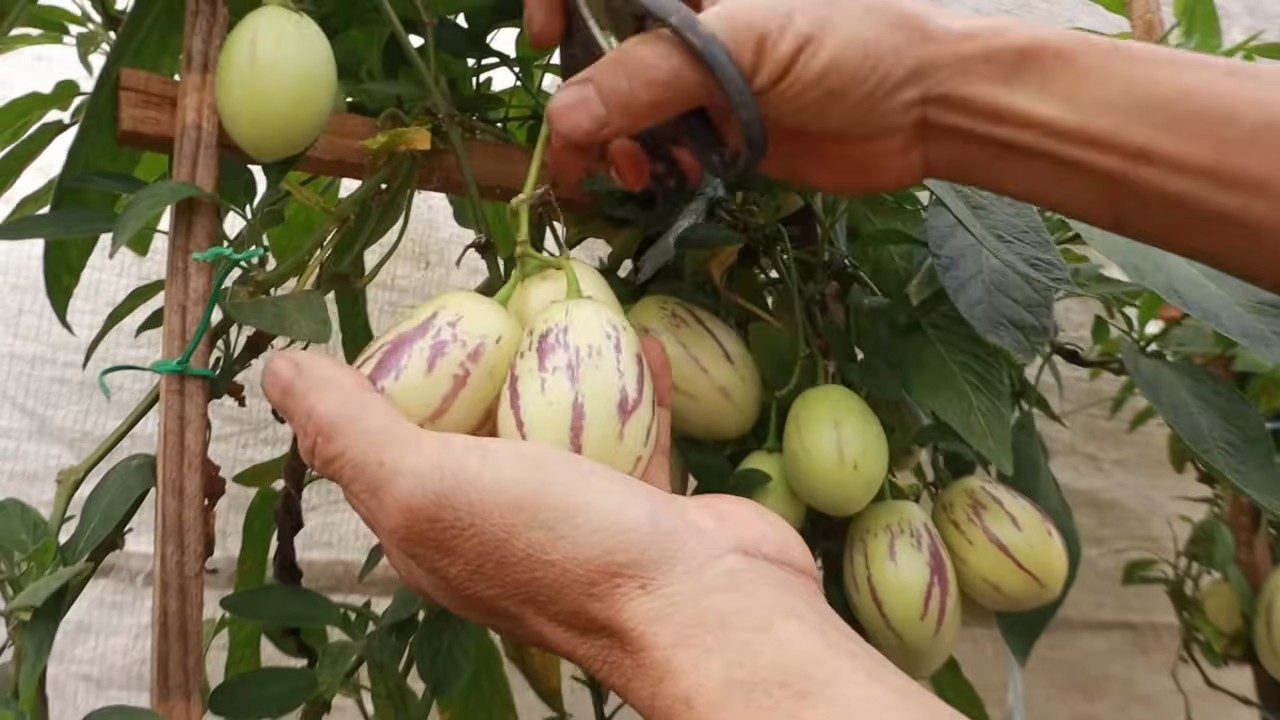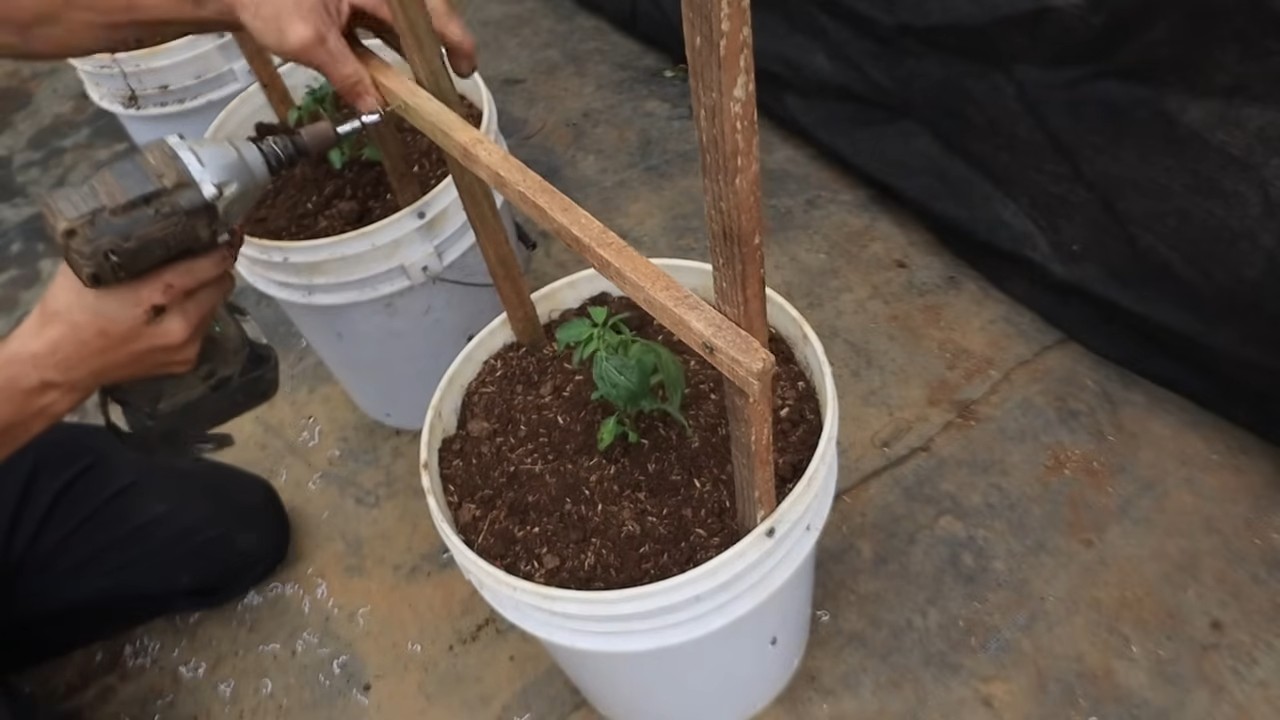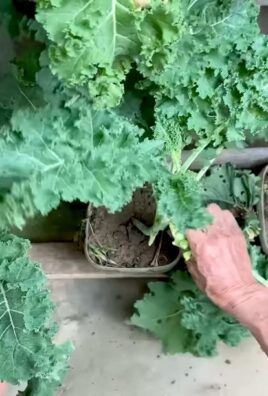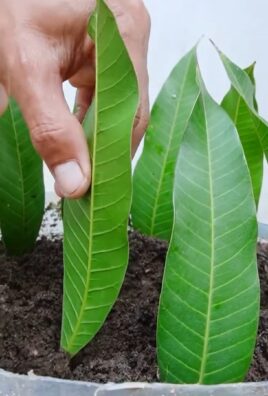Grow Pepino Melon at Home and unlock a world of sweet, juicy goodness right in your backyard! Have you ever dreamt of biting into a refreshingly unique fruit, one that tastes like a cross between a cantaloupe and a pear? Well, dream no more! This DIY guide will empower you to cultivate your very own Pepino Melon paradise, even if you’re a beginner gardener.
While not as widely known as its melon cousins, the Pepino Melon boasts a fascinating history, originating in the Andean regions of South America. For centuries, indigenous communities have cherished this fruit for its delicious flavor and nutritional benefits. Now, you can bring a piece of that rich heritage to your own garden.
Why should you embark on this exciting gardening adventure? Because store-bought Pepino Melons can be expensive and often lack the vibrant flavor of homegrown ones. Plus, there’s nothing quite like the satisfaction of nurturing a plant from seed to fruit, knowing you’ve created something truly special. I’m here to guide you through every step, from selecting the right seeds to harvesting your bountiful crop. Let’s grow Pepino Melon at Home and enjoy the fruits (literally!) of our labor!

Growing Pepino Melon: A DIY Guide to Sweet Success!
Hey there, fellow gardening enthusiasts! Ever heard of a Pepino Melon? It’s this amazing fruit that tastes like a cross between a cantaloupe and a cucumber – seriously delicious! And guess what? You can totally grow it at home. I’ve been doing it for a few years now, and I’m here to share all my secrets to help you cultivate your own Pepino Melon patch. Let’s get started!
What You’ll Need
Before we dive into the nitty-gritty, let’s gather our supplies. Here’s a list of everything you’ll need to successfully grow Pepino Melons:
* Pepino Melon Seeds or Cuttings: You can find these online or at specialty nurseries. Cuttings are often faster to get fruit.
* Seed Starting Tray or Small Pots: If you’re starting from seed.
* Seed Starting Mix: A light, well-draining mix is crucial for germination.
* Potting Soil: A good quality potting mix for transplanting.
* Larger Pots (at least 5 gallons): Pepino Melons need room to grow, especially if you’re container gardening.
* Well-Draining Garden Soil: If you’re planting directly in the ground.
* Fertilizer: A balanced fertilizer (like 10-10-10) and a bloom-boosting fertilizer (higher in phosphorus) are ideal.
* Watering Can or Hose: For regular watering.
* Trellis or Stakes: Pepino Melons can get quite bushy and benefit from support.
* Pruning Shears: For trimming and shaping the plant.
* Sunny Location: Pepino Melons need at least 6-8 hours of sunlight per day.
* Patience: Gardening always requires a little patience!
Starting from Seed (Optional)
If you’re starting from seed, this is the first step. It’s a bit more time-consuming than using cuttings, but it’s totally doable!
1. Sow the Seeds: Fill your seed starting tray or small pots with seed starting mix. Moisten the mix thoroughly. Sow the Pepino Melon seeds about ¼ inch deep. Gently cover them with soil.
2. Provide Warmth and Moisture: Pepino Melon seeds need warmth to germinate. Aim for a soil temperature of around 70-75°F (21-24°C). You can use a heat mat to help with this. Keep the soil consistently moist, but not soggy.
3. Wait for Germination: Germination can take anywhere from 10-21 days, so be patient. Once the seedlings emerge, provide them with plenty of light. A grow light is helpful if you don’t have a sunny windowsill.
4. Thin the Seedlings: If you sowed multiple seeds in each pot, thin them out to one strong seedling per pot once they have a few true leaves.
Propagating from Cuttings (Recommended)
This is my preferred method because it’s faster and often more reliable. You can get cuttings from a friend who already grows Pepino Melons or sometimes find them at nurseries.
1. Take the Cuttings: Choose healthy, non-flowering stems that are about 4-6 inches long. Make a clean cut just below a node (where a leaf grows).
2. Prepare the Cuttings: Remove the lower leaves from the cutting, leaving only a few leaves at the top. This will help prevent rot.
3. Rooting Hormone (Optional): Dip the cut end of the cutting in rooting hormone powder. This will encourage root development.
4. Plant the Cuttings: Fill small pots with a well-draining potting mix. Moisten the mix. Insert the cuttings into the soil, burying the bottom node.
5. Create a Humid Environment: Cover the pots with a plastic bag or humidity dome to create a humid environment. This will help the cuttings root.
6. Provide Warmth and Light: Place the cuttings in a warm, bright location, but avoid direct sunlight.
7. Wait for Roots to Develop: It usually takes about 2-4 weeks for roots to develop. You can gently tug on the cuttings to check for resistance, which indicates root growth.
Transplanting Your Pepino Melon
Whether you started from seed or cuttings, it’s time to transplant your Pepino Melon into a larger pot or directly into the garden.
1. Harden Off Seedlings (if applicable): If you started from seed indoors, you’ll need to harden off the seedlings before transplanting them outdoors. This means gradually exposing them to outdoor conditions over a period of 7-10 days. Start by placing them in a sheltered spot for a few hours each day, gradually increasing the amount of time they spend outdoors.
2. Choose a Location: Select a sunny location with well-draining soil. Pepino Melons need at least 6-8 hours of sunlight per day.
3. Prepare the Soil: If you’re planting in the ground, amend the soil with compost or other organic matter to improve drainage and fertility.
4. Dig a Hole: Dig a hole that’s slightly larger than the root ball of your Pepino Melon plant.
5. Transplant Carefully: Gently remove the plant from its pot and loosen the roots slightly. Place the plant in the hole and backfill with soil.
6. Water Thoroughly: Water the plant thoroughly after transplanting.
Caring for Your Pepino Melon Plant
Now that your Pepino Melon is planted, it’s time to provide it with the care it needs to thrive.
1. Watering: Water your Pepino Melon plant regularly, especially during hot, dry weather. Aim to keep the soil consistently moist, but not soggy. Check the soil moisture by sticking your finger into the soil. If the top inch feels dry, it’s time to water.
2. Fertilizing: Fertilize your Pepino Melon plant every 2-3 weeks with a balanced fertilizer (like 10-10-10). Once the plant starts to flower, switch to a bloom-boosting fertilizer (higher in phosphorus) to encourage fruit production.
3. Pruning: Pepino Melons can get quite bushy, so pruning is important to maintain good air circulation and encourage fruit production. Remove any suckers (shoots that grow from the base of the plant) and trim back any overly crowded branches.
4. Support: Pepino Melons benefit from support, such as a trellis or stakes. This will help keep the fruit off the ground and prevent it from rotting.
5. Pest and Disease Control: Keep an eye out for pests and diseases. Common pests include aphids, whiteflies, and spider mites. You can control these pests with insecticidal soap or neem oil. Diseases are less common, but powdery mildew can sometimes be a problem. Improve air circulation and avoid overhead watering to prevent powdery mildew.
Pollination
Pepino Melons are self-pollinating, meaning they don’t need another plant to produce fruit. However, sometimes the flowers need a little help with pollination, especially if you’re growing them indoors.
1. Hand Pollination (if needed): Use a small paintbrush to transfer pollen from the male flowers to the female flowers. Male flowers have a thin stem, while female flowers have a small swelling at the base (the developing fruit).
Harvesting Your Pepino Melon
The moment you’ve been waiting for! Harvesting your Pepino Melon is the most rewarding part of the process.
1. Look for Color Change: Pepino Melons are ready to harvest when they turn from green to a pale yellow or cream color.
2. Check for Softness: The fruit should also be slightly soft to the touch.
3. Gently Twist: Gently twist the fruit from the vine. If it’s ripe, it should come off easily.
4. Enjoy! Pepino Melons can be eaten fresh, added to salads, or used in desserts. They’re also delicious grilled or roasted.
Troubleshooting
Even with the best care, you might encounter some challenges along the way. Here are a few common problems and how to fix them:
* Yellowing Leaves: This could be a sign of overwatering, underwatering, or nutrient deficiency. Adjust your watering schedule and fertilize the plant if needed.
* Lack of Fruit: This could be due to poor pollination, lack of sunlight, or nutrient deficiency. Try hand-pollinating the flowers, move the plant to a sunnier location, and fertilize with a bloom-boosting fertilizer.
* Pests: Treat pests with insecticidal soap or neem oil.
* Diseases: Improve air circulation and avoid overhead watering to prevent diseases.

Conclusion
So, there you have it! Growing pepino melon at home is not only achievable but also incredibly rewarding. Forget relying on expensive, often bland, store-bought options. With a little patience and the right approach, you can cultivate your own supply of these uniquely flavored fruits, bursting with freshness and a taste that far surpasses anything you can find commercially.
This DIY trick, focusing on [specific aspect of growing, e.g., optimal soil composition, strategic pruning, or effective pest control – choose one based on the article’s content, and replace this bracketed text accordingly], is a game-changer. It addresses a common challenge faced by home gardeners and provides a simple, effective solution that significantly increases your chances of a successful harvest. Imagine the satisfaction of biting into a juicy, homegrown pepino melon, knowing you nurtured it from seedling to fruit. That’s an experience worth pursuing!
But don’t stop there! Experiment with different varieties of pepino melon to discover your personal favorite. Try growing them in containers if you have limited space, or explore different trellising methods to maximize your yield. Consider companion planting with herbs like basil or mint, which can help deter pests and enhance the flavor of your melons. You could even try grafting your pepino melon onto a more vigorous rootstock for increased disease resistance and productivity. The possibilities are endless!
We’re confident that once you try this DIY trick for growing pepino melon at home, you’ll be hooked. It’s a fantastic way to connect with nature, enjoy fresh, healthy produce, and impress your friends and family with your gardening prowess. Don’t be afraid to get your hands dirty and embrace the learning process. Every gardener, regardless of experience level, faces challenges, but the rewards of homegrown pepino melon are well worth the effort.
Now, it’s your turn! We encourage you to give this a try and share your experiences with us. Let us know what worked for you, what challenges you encountered, and any tips or tricks you discovered along the way. Your feedback will not only help us improve this guide but also inspire other gardeners to embark on their own pepino melon growing adventures. Share your photos, stories, and questions in the comments below. Let’s build a community of pepino melon enthusiasts together! Happy gardening!
Frequently Asked Questions (FAQ)
What exactly is a pepino melon, and what does it taste like?
The pepino melon (Solanum muricatum) is a fruit native to South America. It’s often described as having a flavor that’s a cross between a melon, cucumber, and pear. The taste can vary depending on the variety and ripeness, but generally, it’s sweet, slightly tangy, and very refreshing. The texture is crisp and juicy, similar to a melon. Many people enjoy eating them fresh, adding them to salads, or using them in desserts.
How long does it take to grow a pepino melon from seed?
Growing pepino melons from seed can take anywhere from 4 to 6 months to produce mature fruit. The germination process itself can take 1 to 3 weeks. After germination, the seedlings need to be nurtured indoors for several weeks before transplanting them outdoors (or into larger containers) once the weather is warm enough. The time to harvest will depend on the specific variety and growing conditions.
What are the ideal growing conditions for pepino melons?
Pepino melons thrive in warm, sunny locations with well-drained soil. They prefer temperatures between 65°F and 80°F (18°C and 27°C). They need at least 6-8 hours of direct sunlight per day. The soil should be fertile and slightly acidic to neutral (pH 6.0-7.0). Consistent watering is crucial, especially during hot weather, but avoid overwatering, which can lead to root rot. Providing support, such as a trellis or stake, is also important as the plants can become quite bushy and the fruits can be heavy.
What are some common problems when growing pepino melons, and how can I prevent them?
Some common problems include pests like aphids, whiteflies, and spider mites. Regularly inspect your plants and treat any infestations promptly with insecticidal soap or neem oil. Fungal diseases, such as powdery mildew, can also be an issue, especially in humid conditions. Ensure good air circulation around the plants and avoid overhead watering. Root rot can occur if the soil is poorly drained or if the plants are overwatered. Use well-draining soil and water only when the top inch of soil feels dry. Blossom end rot, caused by calcium deficiency, can also affect the fruit. Ensure the soil has adequate calcium and maintain consistent watering to prevent this.
So, there you have it! Growing pepino melon at home is not only achievable but also incredibly rewarding. Forget relying on expensive, often bland, store-bought options. With a little patience and the right approach, you can cultivate your own supply of these uniquely flavored fruits, bursting with freshness and a taste that far surpasses anything you can find commercially.
This DIY trick, focusing on [specific aspect of growing, e.g., optimal soil composition, strategic pruning, or effective pest control – choose one based on the article’s content, and replace this bracketed text accordingly], is a game-changer. It addresses a common challenge faced by home gardeners and provides a simple, effective solution that significantly increases your chances of a successful harvest. Imagine the satisfaction of biting into a juicy, homegrown pepino melon, knowing you nurtured it from seedling to fruit. That’s an experience worth pursuing!
But don’t stop there! Experiment with different varieties of pepino melon to discover your personal favorite. Try growing them in containers if you have limited space, or explore different trellising methods to maximize your yield. Consider companion planting with herbs like basil or mint, which can help deter pests and enhance the flavor of your melons. You could even try grafting your pepino melon onto a more vigorous rootstock for increased disease resistance and productivity. The possibilities are endless!
We’re confident that once you try this DIY trick for growing pepino melon at home, you’ll be hooked. It’s a fantastic way to connect with nature, enjoy fresh, healthy produce, and impress your friends and family with your gardening prowess. Don’t be afraid to get your hands dirty and embrace the learning process. Every gardener, regardless of experience level, faces challenges, but the rewards of homegrown pepino melon are well worth the effort.
Now, it’s your turn! We encourage you to give this a try and share your experiences with us. Let us know what worked for you, what challenges you encountered, and any tips or tricks you discovered along the way. Your feedback will not only help us improve this guide but also inspire other gardeners to embark on their own pepino melon growing adventures. Share your photos, stories, and questions in the comments below. Let’s build a community of pepino melon enthusiasts together! Happy gardening!
Frequently Asked Questions (FAQ)
What exactly is a pepino melon, and what does it taste like?
The pepino melon (Solanum muricatum) is a fruit native to South America. It’s often described as having a flavor that’s a cross between a melon, cucumber, and pear. The taste can vary depending on the variety and ripeness, but generally, it’s sweet, slightly tangy, and very refreshing. The texture is crisp and juicy, similar to a melon. Many people enjoy eating them fresh, adding them to salads, or using them in desserts.
How long does it take to grow a pepino melon from seed?
Growing pepino melons from seed can take anywhere from 4 to 6 months to produce mature fruit. The germination process itself can take 1 to 3 weeks. After germination, the seedlings need to be nurtured indoors for several weeks before transplanting them outdoors (or into larger containers) once the weather is warm enough. The time to harvest will depend on the specific variety and growing conditions.
What are the ideal growing conditions for pepino melons?
Pepino melons thrive in warm, sunny locations with well-drained soil. They prefer temperatures between 65°F and 80°F (18°C and 27°C). They need at least 6-8 hours of direct sunlight per day. The soil should be fertile and slightly acidic to neutral (pH 6.0-7.0). Consistent watering is crucial, especially during hot weather, but avoid overwatering, which can lead to root rot. Providing support, such as a trellis or stake, is also important as the plants can become quite bushy and the fruits can be heavy.
What are some common problems when growing pepino melons, and how can I prevent them?
Some common problems include pests like aphids, whiteflies, and spider mites. Regularly inspect your plants and treat any infestations promptly with insecticidal soap or neem oil. Fungal diseases, such as powdery mildew, can also be an issue, especially in humid conditions. Ensure good air circulation around the plants and avoid overhead watering. Root rot can occur if the soil is poorly drained or if the plants are overwatered. Use well-draining soil and water only when the top inch of soil feels dry. Blossom end rot, caused by calcium deficiency, can also affect the fruit. Ensure the soil has adequate calcium and maintain consistent watering to prevent this.
Can I grow pepino melons in containers?
Yes, pepino melons can be successfully grown in containers, making them a great option for gardeners with limited space. Choose a large container, at least 12 inches in diameter, to provide enough room for the roots to grow. Use a high-quality potting mix that drains well. Ensure the container has drainage holes to prevent waterlogging. Place the container in a sunny location and provide support for the plant as it grows. Water regularly and fertilize every few weeks with a balanced fertilizer.
How do I know when a pepino melon is ripe?
A ripe pepino melon will have a slightly soft feel to the touch and a fragrant aroma. The skin color will change from green to a pale yellow or cream color, often with purple stripes. The fruit should detach easily from the vine when gently pulled. Taste is the best indicator of ripeness; a ripe pepino melon will be sweet and juicy.
What are some ways to use pepino melons in cooking?
Pepino melons can be eaten fresh, added to salads, or used in desserts. They can be sliced and eaten as a snack, added to fruit salads, or blended into smoothies. They can also be grilled or baked. In savory dishes, they can be used in salsas, chutneys, or as a garnish for grilled meats or fish. Their mild flavor makes them a versatile ingredient in both sweet and savory recipes.
Is it necessary to prune pepino melon plants?
Yes, pruning pepino melon plants can help improve air circulation, promote fruit production, and prevent the plants from becoming too overgrown. Remove any suckers (shoots that grow from the base of the plant) and any dead or yellowing leaves. You can also prune the tips of the branches to encourage bushier growth and more fruit production. Regular pruning will help keep the plants healthy and productive.
Can I save seeds from my pepino melons to grow more plants?
Yes, you can save seeds from your pepino melons, but keep in mind that the resulting plants may not be identical to the parent plant, especially if the parent plant was a hybrid variety. To save seeds, allow the fruit to fully ripen on the vine. Scoop out the seeds and rinse them thoroughly to remove any pulp. Spread the seeds on a paper towel and allow them to dry completely. Store the dried seeds in an airtight container in a cool, dark place.
What kind of fertilizer should I use for pepino melons?
Pepino melons benefit from regular fertilization. Use a balanced fertilizer (e.g., 10-10-10) every few weeks during the growing season. You can also supplement with a fertilizer that is higher in phosphorus to encourage fruit production. Avoid over-fertilizing, as this can lead to excessive vegetative growth and reduced fruit yield. Organic options like compost tea or fish emulsion can also be used.




Leave a Comment